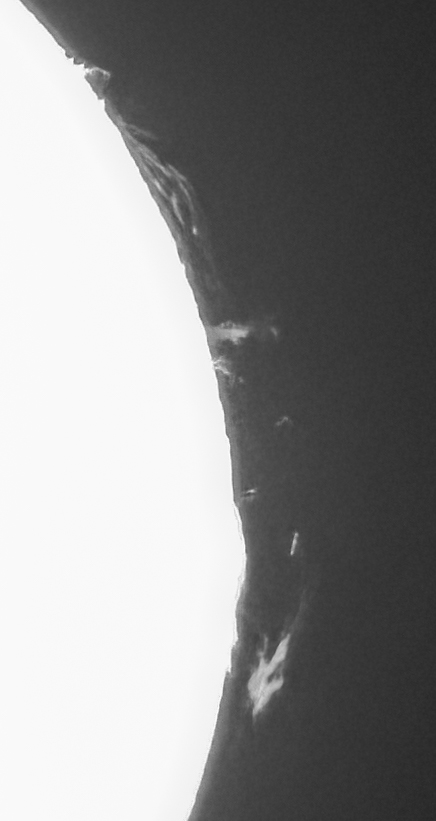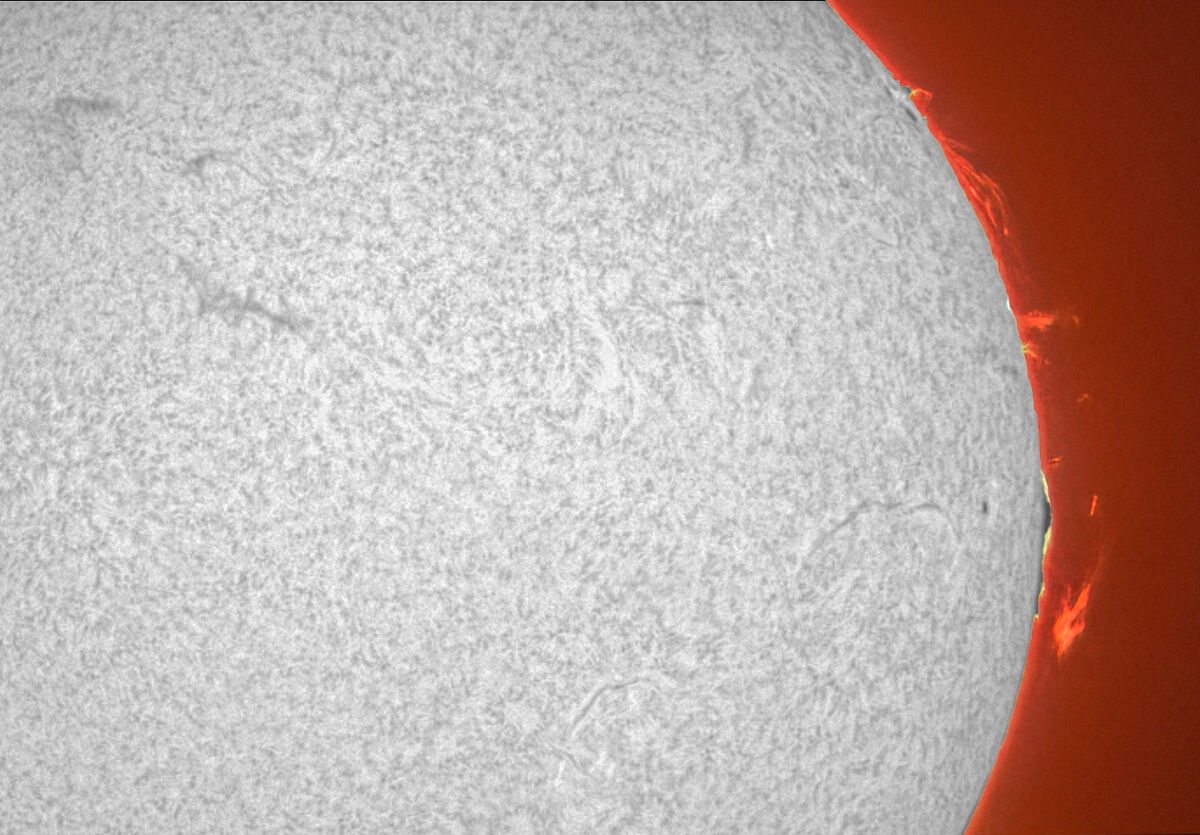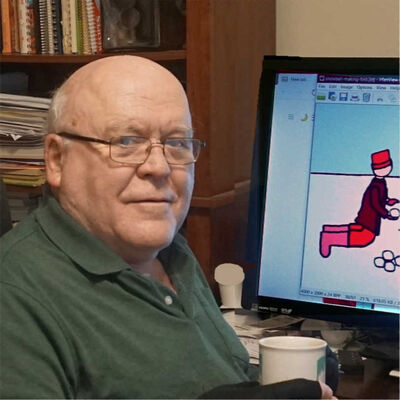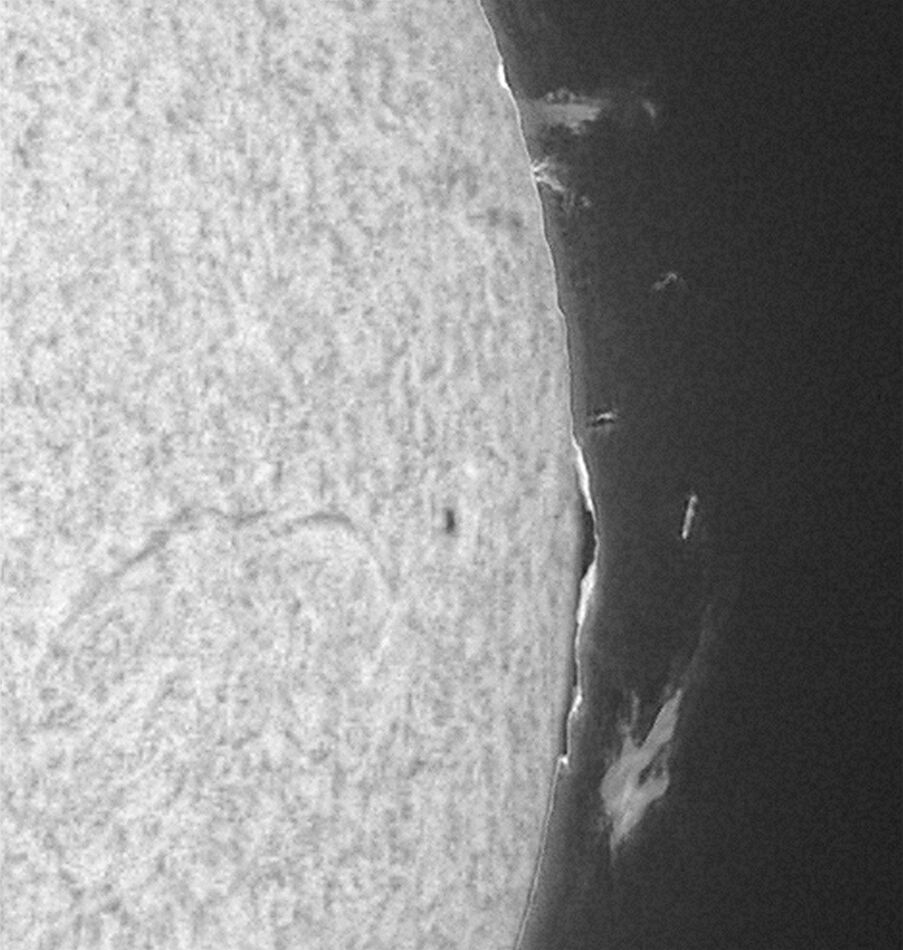Hydrogen Alpha Solar
Mar 30, 2024 17:51:38 #
After missing the largest sunspot region todate due to cloudy weather I fired up the QHY 462C and Lunt 60 this afternoon and short a few video sessions. I only processed two and created a composite, attached.
Lots of prominences in the area where Active Area 3615 disappeared over the edge of ol' sol.
Enjoy!
bwa
Lots of prominences in the area where Active Area 3615 disappeared over the edge of ol' sol.
Enjoy!
bwa
Mar 31, 2024 11:08:53 #
I love your work! Making the (almost) invisible, visible! A noble pastime, I think!
Mar 31, 2024 12:17:37 #
Retired CPO wrote:
I love your work! Making the (almost) invisible, visible! A noble pastime, I think!
In the case of the Sun, making the bright dimmer :)
bwa
Mar 31, 2024 13:44:21 #
bwana wrote:
In the case of the Sun, making the bright dimmer :)
bwa
bwa
That too!


Mar 31, 2024 17:00:21 #
Apr 1, 2024 10:16:06 #
bwana wrote:
After missing the largest sunspot region todate due to cloudy weather I fired up the QHY 462C and Lunt 60 this afternoon and short a few video sessions. I only processed two and created a composite, attached.
Lots of prominences in the area where Active Area 3615 disappeared over the edge of ol' sol.
Enjoy!
bwa
Lots of prominences in the area where Active Area 3615 disappeared over the edge of ol' sol.
Enjoy!
bwa
I like seeing the Sun in the H-alpha line. It clearly shows the granulation in the photosphere. Thanks for sharing this neat photo. BTW, if you don't mind sharing, what brand and model of filter did you use?
Hey, could you also post a less processed image? For example, one without the reddish tone in the corona to the outside of the sun's disk and simply in grayscale? I was trying to see more details in the prominences, and I'm guessing we would see more with no coloration. Or on second thought, it may be better to see the disturbances on the Sun's surface in visible light. Whatt do you think? --Richard
Apr 1, 2024 12:54:46 #
profbowman wrote:
I like seeing the Sun in the H-alpha line. It clea... (show quote)
As noted in the article, I used a Lunt 60 solar scope. There is also normally a UV/IR filter on the camera.
Easy enough to convert proms to B&W, attached.
White Light and Hydrogen Alpha scopes show different features. White Light is normally better for sunspots. Hydrogen Alpha is normally best for tendrils, granulation and, definitely, prominences.
bwa

Apr 1, 2024 16:46:12 #
bwana wrote:
As noted in the article, I used a Lunt 60 solar scope. There is also normally a UV/IR filter on the camera.
Easy enough to convert proms to B&W, attached.
White Light and Hydrogen Alpha scopes show different features. White Light is normally better for sunspots. Hydrogen Alpha is normally best for tendrils, granulation and, definitely, prominences.
bwa
Easy enough to convert proms to B&W, attached.
White Light and Hydrogen Alpha scopes show different features. White Light is normally better for sunspots. Hydrogen Alpha is normally best for tendrils, granulation and, definitely, prominences.
bwa
With my weak eyesight, I missed the reference to the Lunt 60 in your first post. Sorry about that. And I had already made a b&w (grayscale) of your photo [see attached], but I was just wondering if if your original data might have had a bit more detail. So, thanks for sending that, too.
On the photo section I enlarged and enhanced, one can see what I believe is a filament that shows up because we are looking straight down on top of a prominence. Is this your thought, too.
What I was wondering about when I asked about the filter was how good the filter was? In particular, did the blocked wavelength regions match where the camera's sensor was sensitive so that only the 393..4 nm line came through to the sensor. One does not want any of the near infrared region nor the long wavelength ultraviolet to get the sensor or the sensor would record that unwanted light.
BTW, the specs for the Lunt 60 claim a bandpass of 2.2 A. I have not done the calculation yet, but I was wondering if that is wide enough that the blue- and Doppler effects of the rotating edges of the Sun's disk are still within the filter's allowed region or not.
That might be an interesting calculation if one is interested in that kind of detail.
Thanks again for your helpful data. --Richard
Apr 1, 2024 19:19:06 #
profbowman wrote:
With my weak eyesight, I missed the reference to t... (show quote)
The Lunt 60 is tunable to some extent, i.e.: from no surface features to no proms to reasonable detail but regarding the blue and Doppler effects, I don't know.
bwa
Apr 7, 2024 12:48:51 #
Apr 9, 2024 18:23:35 #
lmTrying
Loc: WV Northern Panhandle
bwana wrote:
After missing the largest sunspot region todate due to cloudy weather I fired up the QHY 462C and Lunt 60 this afternoon and short a few video sessions. I only processed two and created a composite, attached.
Lots of prominences in the area where Active Area 3615 disappeared over the edge of ol' sol.
Enjoy!
bwa
Lots of prominences in the area where Active Area 3615 disappeared over the edge of ol' sol.
Enjoy!
bwa
Great photos. Amazing detail. But what is the bump at 3:00 o'clock?
Apr 9, 2024 18:34:29 #
lmTrying wrote:
Great photos. Amazing detail. But what is the bump at 3:00 o'clock?
Active Region 3590 had just gone off the right edge of the sun in this location. It was a huge sunspot and I suspect it was the cause of the 'bump'.
bwa
Apr 9, 2024 19:05:03 #
lmTrying
Loc: WV Northern Panhandle
bwana wrote:
Active Region 3590 had just gone off the right edge of the sun in this location. It was a huge sunspot and I suspect it was the cause of the 'bump'.
bwa
bwa
Well, that kind of changes my thinking on sun spots. I was thinking they were more like depressions on the surface.
Thanx.
Apr 9, 2024 19:26:58 #
lmTrying wrote:
Well, that kind of changes my thinking on sun spots. I was thinking they were more like depressions on the surface.
Thanx.
Thanx.
They're actually cool spots on the sun with a large amount of magnetic activity, i.e.: sorta looking down on prominences with this activity showing up as the bump you noticed.
If you want to reply, then register here. Registration is free and your account is created instantly, so you can post right away.





